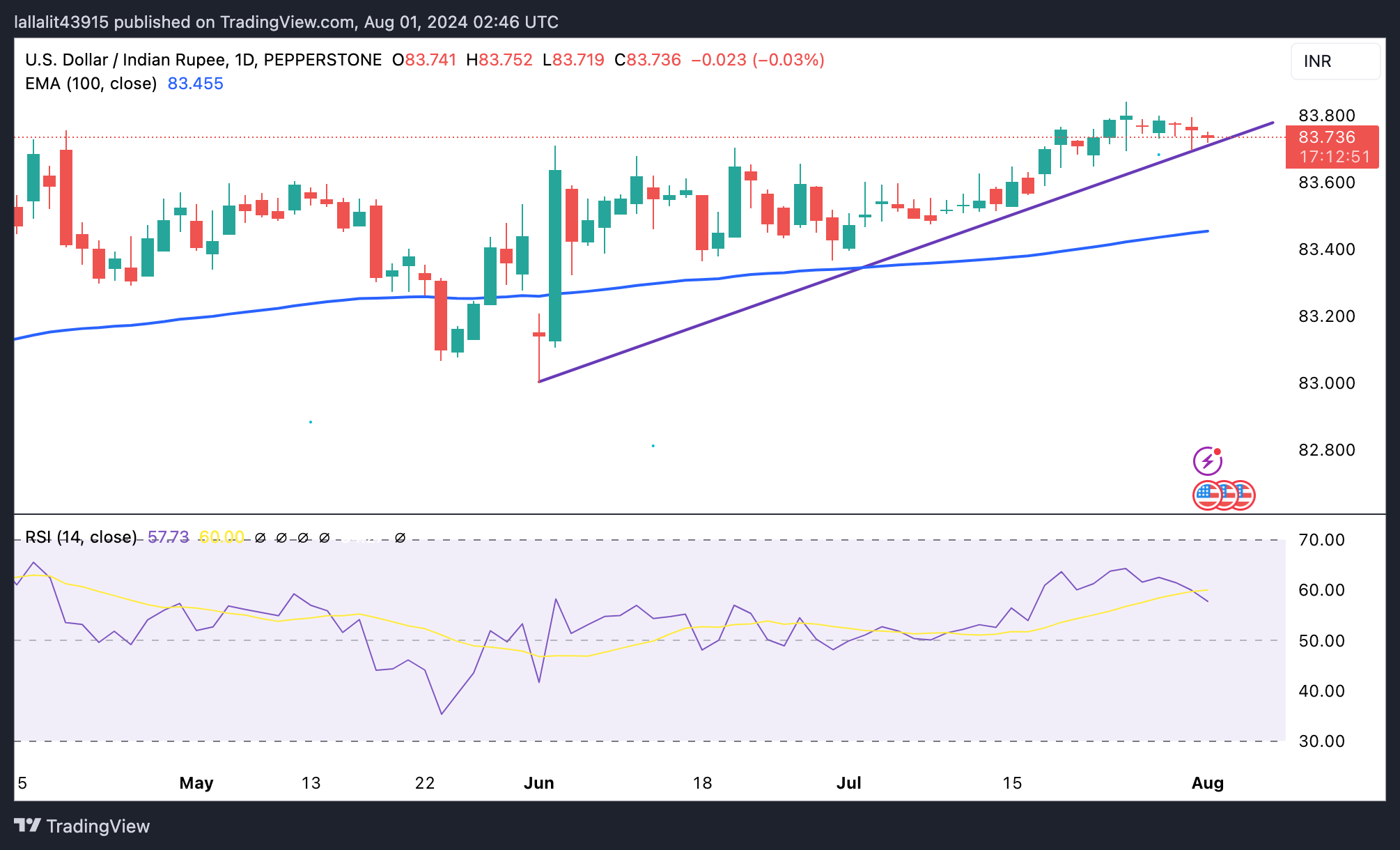Products You May Like
- The Indian Rupee loses ground in Thursday’s Asian session.
- Indian HSBC Manufacturing PMI came in weaker than expected, declining to 58.1 in July vs. 58.3 prior.
- India’s outflows, renewed USD demand and higher crude oil prices might undermine the INR, while Fed’s dovish could limit losses.
- Market players await the US Manufacturing PMI and weekly Initial Jobless Claims on Thursday for fresh impetus.
The Indian Rupee (INR) edges lower despite the decline of the US Dollar (USD) on Thursday. The latest data showed that India’s HSBC Manufacturing Purchasing Managers Index (PMI) eased to 58.1 in July from 58.3 in the previous reading. This figure was below the market consensus of 59.0. The INR trades with mild bearish bias after the softer-than-expected data.
Additionally, significant outflows from Indian equities, persistent USD demand from importers, and fluctuations in the Chinese Yuan might cap the INR’s upside in the near term. A rise in crude oil prices amid the Middle East geopolitical tensions is likely to weigh on the local currency as India is the third largest consumer of oil behind the US and China.
The US Federal Reserve (Fed) decided to keep its interest rates unchanged in the range of 5.25%-5.50% for the eighth time in a row at its July meeting on Wednesday. The dovish stance of Fed Chair Jerome Powell after the policy meeting could undermined the Greenback broadly.
Looking ahead, traders will keep an eye on the US ISM Manufacturing PMI, weekly Initial Jobless Claims, and the final S&P Global Manufacturing PMI, which are due later on Thursday. The outcome of these reports might offer more hints about the interest rate path in September.
Daily Digest Market Movers: Indian Rupee remains fragile amid global challenges
- India’s Ratings and Research (Ind-Ra) raised its economic growth projection for the current fiscal year to 7.5%, up from its earlier estimate of 7.1%.
- Ind-Ra’s revised growth projection is higher than most other estimates, including those from the Reserve Bank of India (7.2%), the Economic Survey (6.5 to 7%), and the International Monetary Fund (7%).
- The final reading of HSBC Manufacturing PMI is estimated to improve to 58.5 in July from the previous reading of 58.3.
- During the press conference, Fed Chair Jerome Powell said that the first interest rate cut could come “as soon as” the Fed’s next rate meeting in September if the data “continue to point to kind of the direction we would want to see.”
- Powell further stated that the US central bank will closely monitor the labor market and stay vigilant for signs of a potentially sharp downturn.
- Futures traders are now pricing in a 100% possibility that the central bank will cut interest rates by 25 basis points (bps) in its September meeting, according to CME FedWatch Tool.
Technical analysis: USD/INR keeps the bullish vibe in the longer term
Indian Rupee trades softer on the day. The longer-term trend of the USD/INR pair remains bullish, with the price holding around the key 100-day Exponential Moving Average (EMA) and being underpinned by the uptrend line since June 3 on the daily chart. The 14-day Relative Strength Index (RSI) stands above the midline near 58.40, suggesting a potential upside for the time being.
The immediate resistance level is located at the all-time high of 83.85. If the price manages to break above this level, it will spur further upside to the 84.00 psychological level.
On the other hand, the initial support level is seen at the uptrend line around 83.70. If the price breaks below this level, it would signal further selling pressure towards 83.51, a low of July 12. Extended losses will pave the way to 83.45, the 100-day EMA.
US Dollar price this week
The table below shows the percentage change of US Dollar (USD) against listed major currencies this week. US Dollar was the strongest against the Australian Dollar.
| USD | EUR | GBP | CAD | AUD | JPY | NZD | CHF | |
| USD | 0.24% | 0.12% | -0.18% | 0.35% | -2.96% | -1.12% | -0.84% | |
| EUR | -0.24% | -0.12% | -0.42% | 0.13% | -3.19% | -1.36% | -1.10% | |
| GBP | -0.13% | 0.12% | -0.30% | 0.24% | -3.07% | -1.24% | -0.97% | |
| CAD | 0.18% | 0.42% | 0.30% | 0.54% | -2.78% | -0.94% | -0.67% | |
| AUD | -0.38% | -0.11% | -0.23% | -0.53% | -3.34% | -1.49% | -1.21% | |
| JPY | 2.87% | 3.11% | 2.99% | 2.69% | 3.22% | 1.79% | 2.05% | |
| NZD | 1.12% | 1.34% | 1.22% | 0.91% | 1.46% | -1.82% | 0.27% | |
| CHF | 0.84% | 1.08% | 0.96% | 0.67% | 1.20% | -2.10% | -0.27% |
The heat map shows percentage changes of major currencies against each other. The base currency is picked from the left column, while the quote currency is picked from the top row. For example, if you pick the Euro from the left column and move along the horizontal line to the Japanese Yen, the percentage change displayed in the box will represent EUR (base)/JPY (quote).
Fed FAQs
Monetary policy in the US is shaped by the Federal Reserve (Fed). The Fed has two mandates: to achieve price stability and foster full employment. Its primary tool to achieve these goals is by adjusting interest rates. When prices are rising too quickly and inflation is above the Fed’s 2% target, it raises interest rates, increasing borrowing costs throughout the economy. This results in a stronger US Dollar (USD) as it makes the US a more attractive place for international investors to park their money. When inflation falls below 2% or the Unemployment Rate is too high, the Fed may lower interest rates to encourage borrowing, which weighs on the Greenback.
The Federal Reserve (Fed) holds eight policy meetings a year, where the Federal Open Market Committee (FOMC) assesses economic conditions and makes monetary policy decisions. The FOMC is attended by twelve Fed officials – the seven members of the Board of Governors, the president of the Federal Reserve Bank of New York, and four of the remaining eleven regional Reserve Bank presidents, who serve one-year terms on a rotating basis.
In extreme situations, the Federal Reserve may resort to a policy named Quantitative Easing (QE). QE is the process by which the Fed substantially increases the flow of credit in a stuck financial system. It is a non-standard policy measure used during crises or when inflation is extremely low. It was the Fed’s weapon of choice during the Great Financial Crisis in 2008. It involves the Fed printing more Dollars and using them to buy high grade bonds from financial institutions. QE usually weakens the US Dollar.
Quantitative tightening (QT) is the reverse process of QE, whereby the Federal Reserve stops buying bonds from financial institutions and does not reinvest the principal from the bonds it holds maturing, to purchase new bonds. It is usually positive for the value of the US Dollar.

